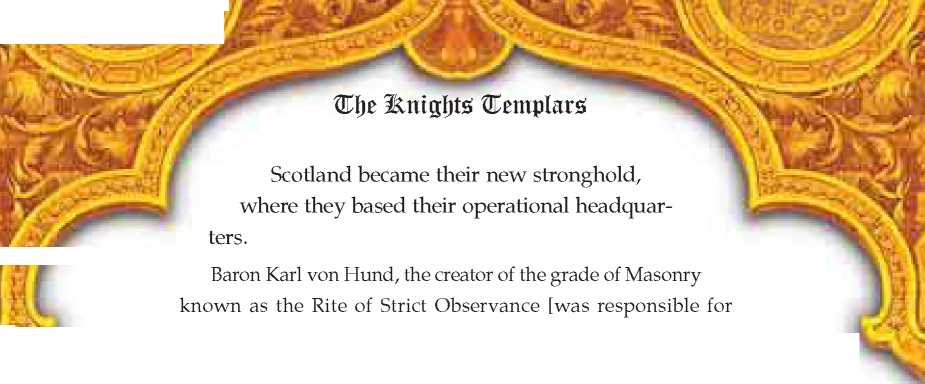The Scottish rite of Freemasonry, oldest of the Masonic lodges employed to provide shelter for the Templars, was established in the 14th century by Templars seeking refuge in Scotland. It became an example for the rest to follow. The titles of the Scottish lodges' highest ranks continue to be identical to those given to the Knights Templar centuries before. Baron Karl von Hund, one of the most famous Masons of the 18th century who compiled research on the Templars, called the Scottish lodges a "restoration" of the Templars. According to him, eight prominent Templars fled first to Ireland and thence to Scotland, where they reorganized. The Templars were soon active again in many other countries, but
AV.
¦0-; K-t
Scotland became their new stronghold, where they based their operational headquarters.


Baron Karl von Hund, the creator of the grade of Masonry known as the Rite of Strict Observance [was responsible for adding the Templar legend to the Craft]. Von Hund's Rite of Strict Observance spread throughout Europe including parts of Switzerland and even as far as Russia. [T]here is no doubt that the Order of the Temple, the highest of the Chivalric Orders in the York Rite, and the Knight Kadosh grade of the Scottish Rite owe a great allegiance to the legend first put forth in Von Hund's Rite of Strict Observance.45
In the following centuries, Masonic Templarism branched out, expanding around the world to become a serious global power, while always remaining true to its Templar ideology:
In 1717 "accepted Masons," working in operative lodges, decided to create for themselves an organization to provide them tolerance and freedom of thought within the religious, political and ideological environment of the 18th century. This organization's signs, traditions and ceremonies were derived from secret societies like Freemasonry, Templars and Rosicrucians. Its philosophy of contemplation was inspired by the idea of free thought, originating in the 17th century and just beginning to spread in England in the 18th.46
As the coming chapters will show, the true ambition hidden in this plan was to weaken and destroy religion, especially Christianity and Islam, by any means, creating a materialistic world order opposed to religion and religious organizations, in line with the Masonic ideals.





 World History
World History









